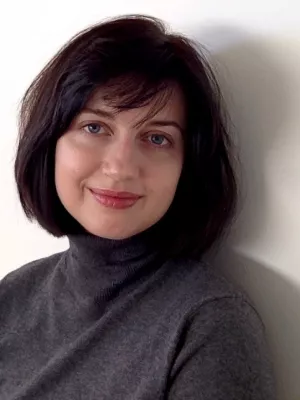
Nataliya Thell
Universitetslektor

Psychotherapeutic utterance: Paradigm features / Психотерапевтическое высказывание: парадигмальные особенности
Författare
Summary, in English
The monograph reports a number of studies of a therapist’s speech. It comprises three chapters. The first chapter is a theoretical introduction into the scientific problem of the psychotherapeutic utterance. It reveals some psychological aspects of language issue, explains the concepts of “utterance” and “psychotherapeutic utterance”, and provides an account of the research methods used for studying a therapist’s speech.
The second chapter presents both quantitative and qualitative approaches in psychotherapy research. In the two quantitative studies existential-humanistic and cognitive-behavioral therapists’ utterances were studied by means of content-analysis, analysis of syntax, and VRMC (Verbal Response Modes Coding). The studies show that distinct differences between cognitive-behavioral and existential-humanistic psychotherapeutic paradigms were observed in therapeutic utterance’s volume and pragmatics. The levels of semantics and syntax showed more clear peculiarities of separate psychotherapeutic methods within the paradigms, such as client-centered, existential, gestalt, rational-emotive, cognitive, multimodal therapies. A number of specific features of tense forms usage, thesaurus, syntactic and pragmatic constructions ratio in psychotherapeutic utterance were revealed for client-centered,existential, gestalt, rational-emotive, cognitive, multimodal therapies.
In the qualitative study existential and cognitive therapists’ speech was investigated by means of conversation analysis. CA as a method for psychotherapy research provides a new insight into the dynamics of psychotherapeutic practice at the level of the interactional detail. Comparative conversation analysis of existential and cognitive therapies showed the fruitfulness of comparative approach in CA of psychotherapeutic interaction. It allowed tracing the ‘fingerprints’ of the therapeutic approaches – showing which features of therapist’s actions are specific to these particular types of psychotherapy.
The third chapter presents two studies of Eastern-European psychotherapy. In particular, the content and structure of Ukrainian and Russian psychotherapists’ speech is compared with the utterances of American psychotherapists. Eastern-European therapist’s verbal behavior showed a number of specific features: emotionality, orientation towards existential concepts of “meaning” and “authenticity”, high metaphoricalness. The study allowed hypothesizing that psychotherapy is carried out within a certain socio-cultural tradition which is voluntary or involuntary transmitted by a practitioner. A therapeutic method itself comprises a certain philosophical-methodological tradition, a system of socio-cultural norms and values relevant for the community in which it has emerged. Thus, the top-priority task of Eastern-European practitioners’ professional education and training seems to be comprehension of their own affiliation with the native culture and corresponding professional actions.
The third chapter offers a questionnaire for therapeutic session assessment by an Eastern-European therapist and a client. The questionnaire includes scales, which reflect some specific features of Ukrainian and Russian psychotherapy.
The second chapter presents both quantitative and qualitative approaches in psychotherapy research. In the two quantitative studies existential-humanistic and cognitive-behavioral therapists’ utterances were studied by means of content-analysis, analysis of syntax, and VRMC (Verbal Response Modes Coding). The studies show that distinct differences between cognitive-behavioral and existential-humanistic psychotherapeutic paradigms were observed in therapeutic utterance’s volume and pragmatics. The levels of semantics and syntax showed more clear peculiarities of separate psychotherapeutic methods within the paradigms, such as client-centered, existential, gestalt, rational-emotive, cognitive, multimodal therapies. A number of specific features of tense forms usage, thesaurus, syntactic and pragmatic constructions ratio in psychotherapeutic utterance were revealed for client-centered,existential, gestalt, rational-emotive, cognitive, multimodal therapies.
In the qualitative study existential and cognitive therapists’ speech was investigated by means of conversation analysis. CA as a method for psychotherapy research provides a new insight into the dynamics of psychotherapeutic practice at the level of the interactional detail. Comparative conversation analysis of existential and cognitive therapies showed the fruitfulness of comparative approach in CA of psychotherapeutic interaction. It allowed tracing the ‘fingerprints’ of the therapeutic approaches – showing which features of therapist’s actions are specific to these particular types of psychotherapy.
The third chapter presents two studies of Eastern-European psychotherapy. In particular, the content and structure of Ukrainian and Russian psychotherapists’ speech is compared with the utterances of American psychotherapists. Eastern-European therapist’s verbal behavior showed a number of specific features: emotionality, orientation towards existential concepts of “meaning” and “authenticity”, high metaphoricalness. The study allowed hypothesizing that psychotherapy is carried out within a certain socio-cultural tradition which is voluntary or involuntary transmitted by a practitioner. A therapeutic method itself comprises a certain philosophical-methodological tradition, a system of socio-cultural norms and values relevant for the community in which it has emerged. Thus, the top-priority task of Eastern-European practitioners’ professional education and training seems to be comprehension of their own affiliation with the native culture and corresponding professional actions.
The third chapter offers a questionnaire for therapeutic session assessment by an Eastern-European therapist and a client. The questionnaire includes scales, which reflect some specific features of Ukrainian and Russian psychotherapy.
Avdelning/ar
- Socialhögskolan
Publiceringsår
2012
Språk
Ryska
Dokumenttyp
Bok
Förlag
Vinnichenko M.D.
Ämne
- Social Work
Status
Published
Projekt
- Negotiating problems and solutions in radio counselling
ISBN/ISSN/Övrigt
- ISBN: 978-966-1569-19-4

